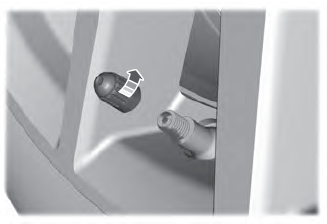Lincoln Corsair: Transmission Cooling - 8-Speed Automatic Transmission – 8F35/8F40 / Diagnosis and Testing - Transmission Cooling
Inspection and Verification
-
Verify the customer concern.
-
Visually inspect for obvious signs of mechanical or electrical damage.
-
If an obvious cause for an observed or reported concern is
found, correct the cause (if possible) before proceeding to the next
step
-
If the cause is not visually evident, verify the symptom and refer to the Symptom Chart.
Diagnostic Trouble Code (DTC) Chart
Diagnostics in this manual assume a certain skill level and knowledge of Ford-specific diagnostic practices.
REFER to: Diagnostic Methods (100-00 General Information, Description and Operation).
Diagnostic Trouble Code Chart
| Module | DTC | Description | Action |
|---|---|---|---|
| TCM | P1783:00 | Transmission Over Temperature Condition: No Sub Type Information | GO to Pinpoint Test B |
| TCM | P2681:00 | Engine Coolant Bypass Valve "A" Control Circuit/Open: No Sub Type Information | GO to Pinpoint Test A |
| TCM | P2682:00 | Engine Coolant Bypass Valve "A" Control Circuit Low: No Sub Type Information | GO to Pinpoint Test A |
| TCM | P2683:00 | Engine Coolant Bypass Valve "A" Control Circuit High: No Sub Type Information | GO to Pinpoint Test A |
Global Customer Symptom Code (GCSC) Chart
Diagnostics in this manual assume a certain skill level and knowledge of Ford-specific diagnostic practices.
REFER to: Diagnostic Methods (100-00 General Information, Description and Operation).
| Symptom | Action |
|---|---|
| Start/Run/Move > Vibration > Moving/Driving > Always | GO to Pinpoint Test D |
| Start/Run/Move > Vibration > Moving/Driving > Intermittent | GO to Pinpoint Test D |
Symptom Chart — Transmission Cooling
Diagnostics in this manual assume a certain skill level and knowledge of Ford-specific diagnostic practices.
REFER to: Diagnostic Methods (100-00 General Information, Description and Operation).
Refer to the DTC Chart before using the Symptom Chart.
| Symptom | Action |
| Transmission overheating | GO to Pinpoint Test C |
| Vibration-a high frequency (20-80 Hz) that is felt through the seat. Changes with engine speed. | GO to Pinpoint Test D |
| Assembly gel present in new or low mileage transmissions | GO to Pinpoint Test E |
Check Transmission Fluid Level and Condition
NOTICE: The vehicle should not be driven if the transmission fluid level indicator shows the transmission fluid below the minimum transmission fluid level mark or internal failure could result.
If the vehicle has been operated for an extended period of time: at highway speeds, in city traffic, in hot weather or while pulling a trailer, the transmission fluid may need to cool down to obtain an accurate reading.
The transmission fluid level reading on the transmission fluid level indicator will differ depending on operating and ambient temperatures. The correct reading should be within the normal operating temperature range.
Transmission Fluid Level Check
To check the transmission fluid level,
REFER to: Transmission
Fluid Level Check (307-01A Automatic Transmission - 8-Speed Automatic
Transmission – 8F35/8F40, General Procedures).
High Transmission Fluid Level
A
transmission fluid level that is too high may cause the transmission
fluid to become aerated due to the churning action of the rotating
internal parts. This will cause erratic control pressure, foaming, loss
of transmission fluid from the vent tube and possible transmission
malfunction and/or damage. If an overfill reading is indicated,
REFER
to: Transmission Fluid Level Check (307-01A Automatic Transmission -
8-Speed Automatic Transmission – 8F35/8F40, General Procedures).
Low Transmission Fluid Level
A low transmission fluid level could result in poor transmission engagement, slipping, malfunction and/or damage. This could also indicate a leak in one of the transmission seals or gaskets.
Transmission Fluid Condition Check
-
Check the transmission fluid level,
REFER to: Transmission Fluid Level Check (307-01A Automatic Transmission - 8-Speed Automatic Transmission – 8F35/8F40, General Procedures).
-
Hold the transmission fluid level indicator over a white
facial tissue and allow the transmission fluid to drip onto the facial
tissue and examine the stain.
-
If evidence of solid material is found, the transmission fluid pan should be removed for further inspection.
-
If transmission fluid contamination or transmission
failure is confirmed by the sediment in the bottom of the transmission
fluid pan, repair the transmission and clean the transmission fluid
cooler tubes and the transmission fluid cooler.
-
If the transmission is to be overhauled or if installing
a new transmission, the transmission fluid cooler must be backflushed.
REFER to: Transmission Fluid Cooler - Backflushing and Cleaning (307-02A Transmission Cooling - 8-Speed Automatic Transmission – 8F35/8F40, General Procedures).
Pinpoint Tests
 PINPOINT TEST A: TRANSMISSION FLUID HEATER COOLANT CONTROL VALVE
PINPOINT TEST A: TRANSMISSION FLUID HEATER COOLANT CONTROL VALVE|
Refer to Wiring Diagrams Cell 22 for schematic and connector information. Normal Operation and Fault Conditions The PCM receives input from the TFT sensor and determines if the transmission fluid heater coolant control valve should be open or closed depending on TFT . The PCM provides a ground to energize the valve as required by transmission fluid conditions. DTC Fault Trigger Conditions
Possible Sources
|
||||||||||||
| A1 RETRIEVE AND RECORD ALL DTCS | ||||||||||||
Was DTC P2681 or P2683 set?
|
||||||||||||
| A2 CHECK BJB (BATTERY JUNCTION BOX) FUSE 8 (15A) | ||||||||||||
Is the resistance less than 5 ohms?
|
||||||||||||
| A3 CHECK THE TRANSMISSION FLUID HEATER COOLANT CONTROL VALVE POWER CIRCUIT FOR A SHORT TO GROUND | ||||||||||||
Is the resistance greater than 10,000 ohms?
|
||||||||||||
| A4 CHECK THE TRANSMISSION FLUID HEATER COOLANT CONTROL VALVE POWER CIRCUIT FOR AN OPEN | ||||||||||||
Is voltage greater than 10 volts?
|
||||||||||||
| A5 CHECK THE TRANSMISSION FLUID HEATER COOLANT CONTROL VALVE CONTROL CIRCUIT FOR A SHORT TO GROUND | ||||||||||||
Is the resistance greater than 10,000 ohms?
|
||||||||||||
| A6 CHECK THE TRANSMISSION FLUID HEATER COOLANT CONTROL VALVE CONTROL CIRCUIT FOR AN OPEN | ||||||||||||
Is the resistance less than 5 ohms?
|
||||||||||||
| A7 CHECK THE TRANSMISSION FLUID HEATER COOLANT CONTROL VALVE | ||||||||||||
|
NOTE: The resistance specification below is for a temperature range between -40°C - 200°C (-40°F - 392°F)
Is the resistance between 15 - 25 ohms?
|
 PINPOINT TEST B: P1783
PINPOINT TEST B: P1783|
Normal Operation and Fault Conditions The PCM receives inputs from the TFT sensor. The PCM uses this information to determine if the transmission is within normal operating temperature. DTC Fault Trigger Conditions
Possible Sources
|
||||||
| B1 RETRIEVE AND RECORD ALL DTCS | ||||||
Was DTC P2681, P2682 or P2683 set?
|
 PINPOINT TEST C: TRANSMISSION OVERHEATING
PINPOINT TEST C: TRANSMISSION OVERHEATING|
Normal Operation and Fault Conditions The PCM receives input from the TFT sensor and determines an overheating condition exists. Restricted or damaged transmission fluid cooler.
Restricted or damaged transmission fluid cooler tubes.
Maximum towing limits of vehicle have been exceeded.
Transmission cooling system leaks.
Internal transmission concerns.
Possible Sources
|
| Diagnostic steps are not provided for this symptom or DTC. REFER to: Diagnostic Methods (100-00 General Information, Description and Operation). |
 PINPOINT TEST D: VIBRATION
PINPOINT TEST D: VIBRATION|
Normal Operation and Fault Conditions A high frequency (20-80 Hz) that is felt through the seat.
Possible Sources
|
| Diagnostic steps are not provided for this symptom or DTC. REFER to: Diagnostic Methods (100-00 General Information, Description and Operation). |
 PINPOINT TEST E: ASSEMBLY GEL PRESENT IN NEW OR LOW MILEAGE TRANSMISSIONS
PINPOINT TEST E: ASSEMBLY GEL PRESENT IN NEW OR LOW MILEAGE TRANSMISSIONS|
Normal Operation and Fault Conditions
Possible Sources
|
| Diagnostic steps are not provided for this symptom or DTC. REFER to: Diagnostic Methods (100-00 General Information, Description and Operation). |
 Description and Operation - Transmission Cooling - Overview
Description and Operation - Transmission Cooling - Overview
Transmission Cooling
This
vehicle is equipped with an external transmission fluid cooler. The
transmission fluid cooler is an oil-to-coolant fluid cooler which is
mounted to the lower LH side of the
transmission...
 General Procedures - Transmission Fluid Cooler - Backflushing and Cleaning
General Procedures - Transmission Fluid Cooler - Backflushing and Cleaning
Special Tool(s) /
General Equipment
Transmission Cooling System Heated Flusher
Materials
Name
Specification
Motorcraft® MERCON® ULV Automatic Transmission FluidXT-12-QULV
WSS-M2C949-A, MERCON® ULV
Flushing
NOTE:
The cooler bypass valve cannot be backflushed...
Other information:
Lincoln Corsair 2020-2025 Owners Manual: Electromagnetic Compatibility
WARNING: Do not place objects or mount equipment on or near the airbag cover, on the side of the front or rear seatbacks, or in areas that may come into contact with a deploying airbag. Failure to follow these instructions may increase the risk of personal injury in the event of a crash...
Lincoln Corsair 2020-2025 Owners Manual: Locking and Unlocking the Doors Using Keyless Entry
Unlocking the Doors Enter the factory-set five-digit code or your personal code. You must press each number within five seconds of each other. The interior lamps illuminate. Note: All doors unlock if you disable the two-stage unlocking feature. To disable the two-stage unlocking feature: Switch the ignition on using an admin key...
Categories
- Manuals Home
- 1st Generation Lincoln Corsair Owners Manual
- 1st Generation Lincoln Corsair Service Manual
- Automatic Transmission - 8-Speed Automatic Transmission – 8F35/8F40
- Overhaul - Main Control Valve Body
- General Procedures - Brake Service Mode Activation and Deactivation
- New on site
- Most important about car
Second Stage: Checking Tire Pressure
WARNING: If the tire does not inflate to the recommended tire pressure within 15 minutes, stop and call roadside assistance.
WARNING: The power plug may get hot after use and should be handled carefully when unplugging.
Check the air pressure of your tires as follows:


 PINPOINT TEST A: TRANSMISSION FLUID HEATER COOLANT CONTROL VALVE
PINPOINT TEST A: TRANSMISSION FLUID HEATER COOLANT CONTROL VALVE

 VIN required to access Guided Routine (PCM)
VIN required to access Guided Routine (PCM)